I'm away for a while. Please come back in January.
Monday, December 14, 2009
Thursday, December 10, 2009
Tiger vs. skinny bird with silly haircut
I took this odd clip at the Lino Park: you've heard of alien vs predator, shark vs bear, Brown vs. Cameron - well here's tiger versus what would normally be a small snack, one would think. Of course tigers are not native to Africa, so it could be that the bird is just too bird-brained to be instinctively terrified. Or perhaps they've become good friends through long incarceration in adjacent pens and they were just chatting through the wire like they do every day.
Can anyone name the bird species?
Tuesday, December 8, 2009
More animals
Killing a bull
Over the past couple of weeks there's been a big public debate (or is it really a media debate?) about a Zulu ritual called ukweshwama, in which a newly accredited regiment of some forty young men are obliged to kill an adult bull with their bare hands. Exactly how they did this was a bit murky, as the ceremony is sacred and so external observers are not allowed. However, Animal Rights Africa recently managed to get hold of some details and some photos, which showed that the bull is treated pretty badly for a while (eyes gouged, tongue ripped out, genitals manhandled, etc.) before eventually having its neck broken; ARA then presented a legal action in a SA High Court to have the ceremony banned. The legal action failed, because the judge accepted the evidence of the Zulus themselves that the bull didn't suffer, much, and their assertion that the ritual was essential to fulfill a cultural requirement, in which the power of the bull is transfered to the neo-warriors and then to the Zulu monarch, King Goodwill Zwelithini (although this reasoning is undermined a bit by the fact that the ritual had fallen into disuse and has recently been revived).
It's difficult to work out what to think about all of this; on the one hand a "modern" "liberal" (and I sometimes like to think I'm one) will decry needless cruelty to animals - it's a clear case, even for meat eaters - we like to think the steak in front of us didn't suffer too much on its way to our plate. On the other hand it also seems right to respect the religions and traditions of others, and it's somehow patronising to assume that "progressive" values are correct and those of traditionalists are wrong. Moreover, as so often in SA, the debate is mixed up with race issues - Zulus weren't allowed to practise their traditions under colonial and then apartheid rule, so if the new South Africa means freedom and tolerance for all cultures, then who is anybody to dictate moral standards to anyone else?
However, there seems to be a line beyond which most people would not accept a cultural practice just because it's a tradition - infibulation, for example, is pretty certainly beyond that line for the vast majority of the human race in the twenty-first century. Perhaps bull-baiting should be over the line too - and perhaps as a European I should be talking to the Spaniards I know about this very issue.
It's difficult to work out what to think about all of this; on the one hand a "modern" "liberal" (and I sometimes like to think I'm one) will decry needless cruelty to animals - it's a clear case, even for meat eaters - we like to think the steak in front of us didn't suffer too much on its way to our plate. On the other hand it also seems right to respect the religions and traditions of others, and it's somehow patronising to assume that "progressive" values are correct and those of traditionalists are wrong. Moreover, as so often in SA, the debate is mixed up with race issues - Zulus weren't allowed to practise their traditions under colonial and then apartheid rule, so if the new South Africa means freedom and tolerance for all cultures, then who is anybody to dictate moral standards to anyone else?
However, there seems to be a line beyond which most people would not accept a cultural practice just because it's a tradition - infibulation, for example, is pretty certainly beyond that line for the vast majority of the human race in the twenty-first century. Perhaps bull-baiting should be over the line too - and perhaps as a European I should be talking to the Spaniards I know about this very issue.
Saturday, December 5, 2009
The evening light show
Most rainfall in South Africa is in the summer, and for the past couple of weeks in Johannesburg this has been delivered by a spectacular storm every evening, generally starting about seven o'clock but sometimes earlier. The rain comes down in bullets - I hear this on my roof, to the extent that conversation or watching TV is impossible over the background roar. At the peak of the storm there's bright cracking forked lighting, generally travelling as normal from the clouds to the earth, but sometimes licking horizontally across the underbelly of the cloud cover. Before, during and after the storm there are all-sky flashes of light which can go on for several hours - this is almost theatrical, like storm effects at the opera. Here are a few seconds from last night:
Tuesday, December 1, 2009
The rest of the Universe
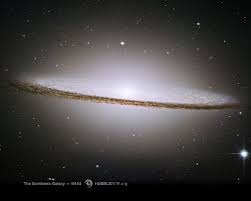 Over the past couple of weeks I've been working my way effortfully through a book which was often very difficult (to me at least) but at the same time poetically written and awe-inducing because of its subject matter - is the universe infinite or finite? and if the latter, how might we measure it? The book is How the Universe Got its Spots by Janna Levin, an American astrophysicist or perhaps cosmologist. It's an unusual mixture of personal diary and an attempt to explain the mathematics and topology of the universe to a lay person - her mother, originally. I can't pretend to have understood more than fifty per cent of it, but Levin succeeds in explaining quite a few of the concepts that have eased into popular culture - and corrected a few of my popular misconceptions too. How about this, for example?:
Over the past couple of weeks I've been working my way effortfully through a book which was often very difficult (to me at least) but at the same time poetically written and awe-inducing because of its subject matter - is the universe infinite or finite? and if the latter, how might we measure it? The book is How the Universe Got its Spots by Janna Levin, an American astrophysicist or perhaps cosmologist. It's an unusual mixture of personal diary and an attempt to explain the mathematics and topology of the universe to a lay person - her mother, originally. I can't pretend to have understood more than fifty per cent of it, but Levin succeeds in explaining quite a few of the concepts that have eased into popular culture - and corrected a few of my popular misconceptions too. How about this, for example?:"The big bang is not an explosion in space like a star exploding, where a ring of nebulous material surrounds an identifiable centre. Rather the big bang is the creation of space itself, of time. There is no sense to the question: how long was it before the big bang happened? Time started with the big bang. There is no sense to the question: where did the big bang happen? It happened everywhere. The earth is at the centre in a sense. Every galaxy is at the centre. The centre is everywhere. The first sketch of our universe, its birth, life and death, begins here."
How can the universe be finite? It would be like one of those video games where one edge of the screen is the same as the opposite edge - if you travel in one distance long enough you get back to where you started. More amazingly, Levin suggests that we can measure the distance between these two identical locations in space by comparing the tiny differences that exist in background radiation and matching them up in both directions - mapping the patterns of "spots" to find those that are the same - they would in fact be the same places.
What does this have to do with SA? Not much - except that my flat here in Dunkeld turns out to be the centre of the universe, just like the place where you are now; and one of the pleasures of going to nature reserves in SA is that they're a long way from cities and so there's no light pollution - you can lay on the ground at night and stare up at an astonishingly bright Milky Way - which is the rest of our galazy, seen edge on, consisting of millions of stars; and is one of billions of observable galaxies - the universe might be finite, but it's certainly very BIG. It tests my brain to consider such things even for a few minutes; I can't imagine a life dedicated to investigating the physics - and topology - and spots - of the universe.
Sunday, November 29, 2009
Imilongi KaNtu Choral Society
Today I went to Soweto to see the end of year concert by Imilongi KaNtu Choral Society - a choir that's been going for 25 years and has performed all over the world. It was a marathon event, lasting over three hours and covering an eclectic range of music from Handel and Mozart to local composer S.J. Khosa and traditional chants and dances. The audience joined in and encouraged the performers with whistles, shouts, ululations, applause and hand-waving - and a bit of dancing in the aisles too. Some of the ladies in the audience had also put on their best traditional costumes, so there was a wash of glorious colours across the hall. Great music and a great atmosphere - especially down in the mosh pit.
Wednesday, November 25, 2009
Joburg Art Deco



Last night at eleven o'clock I was wandering around Johannesburg's notorious CBD - Central Business District - on foot - an area that most of Joburg's northern suburban population would never dream of entering even in broad daylight (and some areas of which even the police don't go into at night). I felt perfectly safe, though - partly because I was in a group of about eighty people, partly because we had security guards escorting us, and partly because the city centre was absolutely deserted - we saw perhaps half a dozen other pedestrians, a handful of cars (the drivers slowing down to take a look at us) and a couple of rubbish trucks.
The occasion was a workshop for architects that I'm slightly involved in - the French Institute organised a bus tour of the CBD for the workshop participants and any interested members of the public; it was then decided that getting on and off the buses was too complicated, so we ended up taking a ninety-minute walking tour. I've driven through the CBD a number of times during rush hour, which in itself is quite an experience - the roads are snarling gridlock and there are people everywhere - so the night-time tour was an astonishing contrast - I was able to walk down the middle of a major four-lane artery without a vehicle in sight, just a long panorama of traffic lights quietly changing colour to themselves in both directions (and no cars parked in the streets, either - cars are generally not left outside overnight in Joburg...)
We saw a lot of wonderful buildings, some sadly derelict and fenced off behind sheets of corrugated metal, others very well maintained with neat golf-course lawns in front of them (vandalism seems to be nearly unknown here; even tagging, that bane of European cities, is pretty rare). I learned that Johannesburg has the third highest number of Art Deco buildings in the world (after, I think, New York and Miami) - although these buildings are "derivative", mere adaptations of American and European models rather than original - but they still look amazing. All the more extraordinary that most people don't know they're there (I'd never heard anyone talking about CBD architecture before and it's not mentioned in any tourist guide that I've seen) and most people probably wouldn't risk getting out of their cars to take a proper look at them even if they knew. I thoroughly recommend checking them out late at night, just take along a group of 79 friends if you can.
I forgot to take my camera, so to get an idea of what I'm talking about check here to see Lucille Davie's photos (mouse over the thumbnails to see the images). My pathetic mobile phone image is above, over a few Google findings.
Tuesday, November 17, 2009
Swazi flora




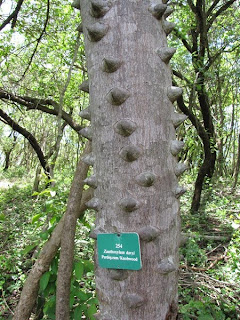
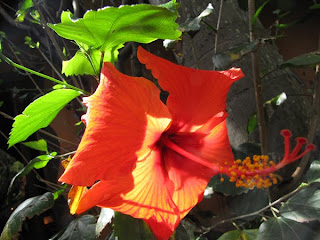

Personally, I find photographs of flowers boring - and not much of a challenge for the photographer either, the subject is hardly going to run away or object to having its image stolen. On the other hand, the vegetation generally in southern Africa (as I think I've said before) is spectacular - so I can't resist...
(I have no idea what any of these are called - my interest in flowers doesn't run as far as asking about names - the weird tree however was thoughtfully labeled "knobwood" although I think this raises more questions than answers.)
Monday, November 16, 2009
Swaziland fauna






Swaziland was a British protectorate from 1906 to 1968 and so, like Lesotho, was never part of the mad South African experiment in social engineering. Swaziland is an absolute monarchy, and the tourist posters and souvenir shops make much of the Umhlanga festival, when twenty thousand young women parade in front of King Mswati III so he can pick one of them out as new wife - to be fair, Mswati doesn't always insist on this perk, and has only chosen thirteen wives so far. His predecessor got to seventy. I noticed in the literature that King Mswati III was educated at Sherbourne College in Dorset, UK, just down the road from where I went to school - I have to wonder what his fellow schoolboys thought of his amorous future.
The north-west part of Swaziland, where we went, is over 1,200 metres. On Saturday the temperature was 25 degrees and extremely humid - walking was a sweaty effort - but when we woke up on Sunday morning it was 12 degrees and very misty - so misty in fact that the staff at Malolotja Nature Reserve, which we were planning to visit, advised us not to bother. Driving down from the hills in the fog, with ranks of fir trees barely visible along the side of the road, felt more like coming away from a European ski resort than leaving an African kingdom in the summer (the only difference was the stray cows in the middle of the road). Is Africa hot? Well southern Africa, at least, is nothing like Calabria in the middle of August, in my experience.
Above: orange millipede; zebra millipede; UFO spider (I'm making these names up - a cousin of this UFO spider hitched a ride on the back of my car all the way to Joburg - he's still there, spinning webs around the rear number plate); large moth (four inches across); female Cape Weaver busy destroying a nest just patiently built by a male (this is part of the mating process - males build nests, a female comes along and rips up the ones she doesn't like and accepts the male who built a good nest in which she'll feel confident about laying her eggs. This seems wasteful, but on the other hand you don't want your eggs falling out when there's a bit of wind); and few feathers on a good old classic peacock - yes there are African peacocks too.
Sunday, November 15, 2009
Phophonyane






I went to Swaziland for the weekend (I'm amazed that I can say this). The Swazi border is about four hours' drive from Joburg on the usual excellent roads - but the border crossing took far longer than it should, partly because there are NO signs to explain the process, so you have to ask random people to find out that you need to park first, go here, go there, get a piece of paper, get it stamped somewhere else, hand it to an immigration officer who crumples it up without looking at it and throws it in a bin, etc (then start again at the Swazi border which was frankly better organised).
However we got to our destination in the end - the Phophonyane Falls "Ecolodge and Nature Reserve" in the northwest corner of the country - a mountainous, heavily forested logging area. The lodge is a few kilometres down a dirt track in an already remote area - and it's a fantastic place; the various cottages and tents (I stayed in a tent) are dotted around in lush sub-tropical vegetation and are connected by paths and footbridges which cross streams of red-brown water heading down to the Phophonyane river - my tent was so close to this river that I slept wonderfully, all background noise (insects, birds, rain) drowned out by the roar of the water. This isn't a game reserve as such (no hungry lions, myopic rhino, etc) so it's safe to walk around - there are well-marked paths that take you over the river, up to viewpoints of the falls, through the trees and back again, with lots of millipedes, spiders, giant snails, flowers, exotic plants and the occasional spider monkey troupe to look at.
(Above: my tent; the path from my tent back up the hill; a black'n'red millipede about five inches long; the biggest snail I've ever seen in my life - about four inches long; a mummy monkey; the falls.)
Sunday, November 8, 2009
Wild dogs



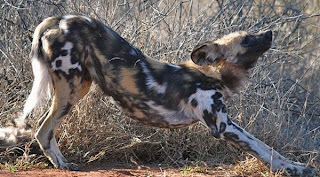

I didn't realise, back in January, how lucky we were to see a pack of wild dogs in the Kruger Park. I've since met South Africans who've been going to game parks all their lives and have never seen a wild dog. They're an endangered species, with less than six thousand estimated to still be alive in the wild - they need to hunt over large territories, because they catch their prey by chasing them to exhaustion - so small parks can't sustain them, and farmers have poisoned most of the packs attempting to live outside of conservation areas.
Are wild dogs (also known as Painted Dogs) attractive or ugly? I thought at first they were a bit repulsive, with their big heavy heads (they have the fiercest bite of any carnivore, related to body size) - but the more I see of them the more I like them - there are a couple in Joburg zoo - and now I think that their markings are wonderful, really very much like various cans of paint have been thrown at them. My friend Rod Burn was showing me some of his excellent wildlife photos today and gave me permission to post some of his pix of wild dogs in the wild - they're much better than the blurry ones I took.
Saturday, October 31, 2009
Psychic with an international reputation
The main intersections in Johannseburg are nodes of commercial enterprise - people walk up and down the lines of waiting traffic collecting for charities (which may or may not exist), selling a wide variety of goods - phone chargers, soft drinks, fruit, mirrors, paintings, toys, footballs - and handing out flyers for any number of services. Yesterday I was given a flyer - purple and green text on a blue background - which extolled the gifts of PROF. LUMUMBA AND .ALI (sic), "psychic with an international reputation" who can, apparently by checking through water and a mirror, tell you all your problems before you mention them. Their specialities include:
- bring back your lover even if you broke up long ago
- remove the bad spell from your life which keeps taking money away from you
- ensure that a single person gets a perfect partner in a shortest time
- attract customers into your business and turn your trade into a favourite among clients
- Masai root joice for weight loss
- Masai remedy xtra for enlarging the breasts to size "D" naturally
- Masai remedy for tightening the breasts making them smaller and firm to the size of your choice permanently
- remove witchcraft, curse or haunting and send them back to your enemy
- make you see your enemies in the mirror and make demands on them
- recover stolen property
- bring super natural luck into your life to win chance games like lotto, casino, dice, black jack machines, etc
- Masai gel for men, mainly intended to enlarge the penis both in girth and length naturally making it big to the size of your choice and strong
- and many more."
Saturday, October 24, 2009
The colour jacaranda

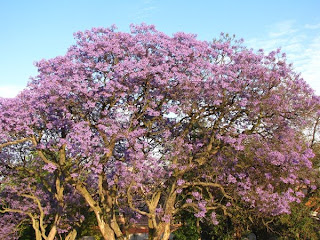

In Johannesburg the jacaranda trees are in bloom again - which means I've been in SA for nearly a year, the seasons will start to repeat themselves from now on (though it still seems very strange for the weather to be getting hotter as we head towards Christmas - today I heard a Christmas carol in a shop; surreal.)
I'd never really thought about exactly what colour Jacaranda flowers are - but a poet said to me the other day in passing, "I'm still trying to work out what colour jacaranda is..." (this was Francesca Beard, who was here for work, check out her website - there's an MP3 archive of her performing her poems) - and this made me look more closely - and the answer is: it depends. Yesterday on the way back from work I drove through a storm along an avenue of jacaranda trees and they looked grey against a slate sky. With the sun behind them they're pale blue. In the morning light they're violet. They change all the time. But whatever the real colour is, they're wonderful, and they add an extra dimension to spring in South Africa.
(Above: taken from my balcony: electrical storm; the jacaranda at the end of my balcony, morning and evening.)
Plunder

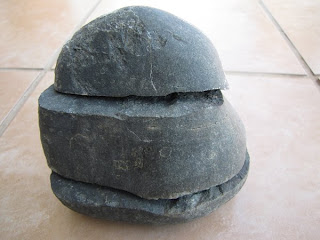




The wonder and excitement of my Namibian holiday have begun to fade, distanced by two weeks back at work... all I have left are the memories, the photos and the objects I picked up along the way.
Above: vertebra from an unknown animal found on the Skeleton Coast (any suggestions?); carved Makalani palm seed; decorated snuff box (snuff is still popular in Namibia, apparently); wooden tortoise; rock from the Namib desert, split by heat (the pieces still fit together perfectly if you line them up); bead lizard.
Tuesday, October 20, 2009
Skeleton Coast




Namibia's coastline is known as the Skeleton Coast, according to some accounts because of the large number of shipwrecks that have happened there, over 500 of them over the centuries (ships get lost in the morning fogs, a feature of the area, and heavy surf and strong tides wash them up on the beach); according to another version the name arose because it's such an inhospitable part of the world that most humans who venture into it, shipwrecked or not, end up dead.
North of Swakop is the Skeleton Coast Park. We didn't drive very far into it because the distances are again huge, so we stopped at the first ship wreck we saw - a fairly recent one, by the looks of it - it still had its paint and didn't seem broken up (it's called the Ze'la - I couldn't find any reference to it on the internet so if anyone knows how to find some information let me know). I would've loved to get on board and see what was left on the ship, but caution easily won the day - this is not a good beach for swimming.
Above the tideline the sand was littered with... bones. Mostly animal bones, one presumes and hopes - I saw an identifiable carcass of a jackal, and we found an enormous vertebra which must have come from a whale - this was half buried in the sand so perhaps the rest of the skeleton was beneath our feet - it's hard to imagine bones that size being scattered around very easily or carted off by scavengers.
Why so many animal bones? Well amazingly enough the area does support quite a lot of wildlife - the plants survive on the sea fogs, herbivores graze the plants (including, apparently, elephants, giraffes and rhinos in some areas), there are a few lions to help natural selection along, and jackals, hyenas and crabs keep the beach clean. Leaving the bones. Skeleton Coast indeed.
Subscribe to:
Posts (Atom)






